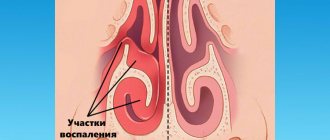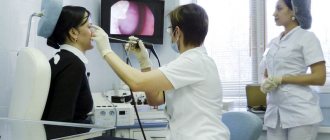Pharyngitis is an inflammatory process that forms on the back wall of the larynx and affects the mucous membrane, as well as deeper layers, tissues of the soft palate and lymph nodes. The acute form of pharyngitis can develop into chronic if the patient does not seek help from a doctor and self-medicates.
Since the pathological process in the larynx is caused by the spread of pathogenic bacteria, the risk of developing pharyngitis increases in people with a weak immune system and in those who suffer from ENT diseases or are predisposed to them.
How dangerous is pharyngitis and how does it manifest itself? Which doctor should I contact and how to treat the disease? We will answer these and other questions in this article.
Reasons for the development of pharyngitis
Experts believe that the peak development of pathology occurs at the end of winter and the beginning of spring, since at this time the human immune system is especially susceptible to colds. Often in the spring season, a lack of vitamins and microelements in the human body leads to the appearance of vitamin deficiency, the body weakens and creates an excellent environment for the development of pathogenic bacteria. Inflammatory processes are also possible: both separately and against the background of the underlying disease.
The first signs of pharyngitis and its further treatment may differ depending on the stage of the pathology, gender, age and general health of the patient.
We include the following as the main reasons for the development of pharyngolaryngitis:
- hypothermia, eating too cold foods;
- deformation of the nasal septum;
- strains of microorganisms that cause the development of chlamydia, candidiasis, whooping cough, scarlet fever, measles;
- adenovirus, influenza virus;
- streptococci, staphylococci, pneumococci;
- sinusitis, tonsillitis, caries, rhinitis;
- difficulty breathing through the nose;
- pathologies of the gastrointestinal tract: reflux, heartburn, hernia;
- abuse of bad habits;
- regular high loads on the vocal cords;
- polluted, toxic air;
- hormonal disorders and endocrine pathologies (diabetes mellitus, obesity, hypothyroidism, etc.);
- tonsillectomy, which was performed on the patient previously;
- infectious diseases in chronic form;
- weakened immunity.
During pregnancy
In pregnant women, pharyngitis is a fairly common disease, since against the background of a natural decrease in immunity, bacterial and viral infections easily affect the mucous membrane. Any inflammation poses a danger to the fetus, and therefore it is important to immediately carry out the correct therapy. It is strictly forbidden to resort to self-medication. Not all drugs can be used during pregnancy, and therefore it is important to accurately select effective and at the same time completely safe drugs. Home treatment can easily lead to serious consequences, such as miscarriage, premature birth or deformities in the physical or mental development of the child. Pharyngitis during pregnancy is a serious condition that requires proper therapy.
Symptoms of pharyngitis
The first signs of the disease may differ depending on the type of pharyngitis. They are both local and general in nature. But there are common signs that are characteristic of any type of pharyngitis: sore throat, bad breath, stuffy ears and difficulty swallowing. With an active inflammatory process, an increase in body temperature above 38° can be observed - this is how the body fights a foreign infection. General signs: sweating, poor appetite, weakness, dizziness, fatigue, fever, chills. Some complain of pain and noise in the ears, and discomfort when exposed to loud sounds.
- During acute catarrhal pharyngitis, swelling and redness of the mucous membranes of the larynx appears. Also, red follicles may form on the back wall of the throat, and clear and slightly cloudy mucus may accumulate. There is swelling and redness of the tongue.
- In the purulent form of acute pharyngitis, ulcers with an accumulation of purulent masses appear on the surface of the posterior pharyngeal wall.
Inhalations
Traditional treatment for subatrophic pharyngitis includes inhalation of hot steam over a saucepan. Medicines used:
Sea buckthorn, peach or olive oil at the rate of 5 drops per 1 glass of water.
- A collection of herbs is used - mint, string, coltsfoot. For inhalation, a solution is prepared using the usual method in a water bath in the proportion of 1 tbsp. l. dry collection per 200 ml of water. The product is infused for 15 minutes in a container under a tight lid. Only under such conditions are essential oils released from plants, which have a healing effect.
- Inhalation of warm steam with tea tree oil, menthol or rosemary relieves the feeling of a lump in the throat. Add 6 drops of essential oil to 0.5 liters of boiling water. The procedure is done twice a day for 10 minutes.
- If the sputum is very thick, use saline solution or mineral water Narzan, Essentuki 17. These products thin the mucus, making it easier to pass.
- Don't forget about inhaling the fumes from hot potatoes.
Before the session, you should gargle with a saline solution prepared at home in a proportion of 1 tsp. for 1 glass of warm water. Inhalations will have a better effect on the epithelium cleared of mucus. After inhaling the steam for 15 minutes, the walls of the throat are lubricated with sea buckthorn oil.
The procedures eliminate dryness and sore throat, dilute mucus, facilitating its removal. During the treatment, the cough that has plagued patients for so long goes away.
Acute pharyngitis
Acute pharyngitis can occur independently, and can also be accompanied by acute inflammation affecting the upper respiratory tract: rhinitis or inflammation of the mucous membranes of the nasopharynx.
Depending on the cause of development, acute pharyngitis occurs:
- Viral – most often caused by rhinovirus;
- Bacterial – caused by streptococci, staphylococci and pneumococci;
- Fungal – source of the inflammatory process – Candida;
- Traumatic - caused by damage to the pharynx and larynx: the throat was scratched by a sharp bone or burned by boiling water, severe stress on the ligaments;
- Allergic – occurs when inhaling allergens or irritants, such as tobacco, exhaust fumes or dusty air.
Preventive actions
It is always easier to prevent a disease. Qualified specialists recommend remembering the prevention of atrophic pharyngitis:
- Go on vacation to places where a warm maritime climate prevails.
- Reduce, or better yet completely stop, the abuse of tobacco and alcohol.
- Maintain proper nutrition. Avoid spicy, fried and dry foods.
- Drink less carbonated drinks.
- Temper your throat, gargle with sea salt.
- Protect yourself from cold air.
- Maintain humidity in the room.
You should not delay going to the doctor if the first symptoms of the inflammatory process appear
It is important to start the treatment prescribed by the doctor as soon as possible. And don’t forget about disease prevention
Chronic pharyngitis
According to the depth of damage to the pharyngeal mucosa, chronic pharyngitis is divided into: catarrhal, hypertrophic and atrophic forms.
- Chronic catarrhal pharyngitis - there is slight swelling of the tissue layers of the pharyngeal mucosa. Individual areas are sometimes covered with clear or slightly cloudy mucus. It develops as a result of acidic gastric contents entering the throat, for example, in the case of a hiatal hernia. Therefore, catarrhal chronic pharyngitis is a consequence of the development of diseases of the gastrointestinal tract.
- Chronic hypertrophic pharyngitis is a significant severity of swelling of the mucous membrane. Additionally, thickening of the uvula and swelling of the soft palate are observed.
- Chronic atrophic pharyngitis is characterized by some thinning of the lining of the pharynx. They are usually pale pink, sometimes shiny varnished. Some of their areas become covered with crusts, viscous mucus and pus.
Any type of chronic pharyngitis develops due to the fact that the acute form of the disease was not cured in time and developed into a more serious form. Chronic pharyngitis also appears as a consequence of rhinitis, sinusitis, deviated nasal septum, nasal polyps - that is, when nasal breathing is difficult for a long time. In addition, long-term use of vasoconstrictor drops also leads to the appearance of chronic pharyngitis.
Herbs
Decoctions and infusions of medicinal herbs have an antiseptic, soothing, anti-inflammatory effect. Collections are also used for various forms of the disease:
- For acute pharyngitis - mix a tablespoon of mint, St. John's wort, and yarrow and pour a glass of boiling water. Drink as a tea, adding honey, before bed, or use as a rinse.
- To treat the chronic form, gargle with infusion of chamomile, oak bark and plantain.
- For atrophic pharyngitis - make inhalations using any herbs or plant oils (sea buckthorn, eucalyptus, mint).
Attention! For pharyngitis caused by reflux esophagitis (reflux of stomach contents back into the esophagus, simply heartburn), the use of mint, menthol, and eucalyptus is not recommended. These substances relax the gastric sphincter, which can make reflux worse.
How to properly treat pharyngitis, watch our video:
How to properly treat pharyngitis, watch our video:
https://youtube.com/watch?v=K8RHEgLRYuI
Infusions, decoctions, teas
- berry, vegetable, fruit drinks;
- warm herbal tea with lemon;
- milk with butter and honey;
- alkaline mineral water without gas;
Cough is also a common symptom of pharyngitis, so you can use herbal decoctions with an expectorant effect:
- plantain;
- sage;
- licorice;
- marshmallow
The usual preparation scheme is 10 g of raw material per glass of boiling water, but now all herbs are often sold in filter bags, and on the packaging itself it is written in detail how to brew the herb, how to store it, and how much to take.
Note! It is not recommended to buy herbs at the market if you do not know where they were collected and are not sure of their quality. It’s better to buy at a pharmacy - there they are collected according to standards, stored and packaged according to standards
Important How long does the temperature last during the flu: an acute process in adults and children, duration by day, how long it lasts and why it doesn’t go down
Gargling, throat treatment
Propolis tincture, which can be bought at a pharmacy, is very good for rinsing. It is diluted with 30 drops per 100 ml of water and gargled 3-4 times a day, but no more, since the product is alcoholic and can irritate the throat.
You can put a couple of drops on a piece of sugar and slowly dissolve. Herbal infusions are also used:
- chamomile;
- calendula;
- Oak bark;
- needles.
For pharyngitis, any antiseptic solutions are used for rinsing. The simplest of them are salt and soda. Effective rinsing means rinsing at least 1 glass of liquid in one procedure. The sip should be large, almost a mouthful.
Inhalations
Inhalations are used to moisturize the mucous membrane of the throat, and a nebulizer is used for this. They are carried out with saline solution, but in some models of the device you can use herbal decoctions.
If you don’t have a nebulizer, you can do inhalations the old-fashioned way - breathe in the steam for 5 minutes twice a day. Such procedures can be carried out using:
- Soda solution (1 teaspoon per glass of boiling water).
- Wet steamed boiled potatoes.
- Decoctions of chamomile, calendula, marshmallow, or other medicinal herbs.
What is the best way to do inhalations, says Dr. Komarovsky:
How does pharyngitis manifest and progress in children?
Children suffer from pharyngitis more severely than adults. This especially applies to babies under one year old. Swelling of the mucous membrane can cause signs of suffocation; the pain that accompanies the disease reduces the child’s appetite. Often, a baby’s body temperature can reach 40°. The most difficult thing in this situation is that a small child cannot say what hurts.
Incorrect treatment can lead to irreparable consequences for a small, fragile organism. Therefore, at the first signs of pharyngitis, consult a doctor immediately.
Forecast
With timely initiation of therapy with the involvement of a doctor and in the absence of complications, the prognosis for the patient is favorable. When the disease is in an advanced state, the treatment was carried out incorrectly and negative consequences began to develop, the prognosis changes to relatively favorable, and in severe cases – to bad. Because of this, it is unacceptable to be negligent in treating the manifestations of pathology. The longer proper treatment is not carried out, the higher the likelihood that the patient’s condition will seriously deteriorate and the prognosis will change for the worse.
Sore throat and pharyngitis: what is the difference?
The general condition of the patient with acute tonsillitis or tonsillitis can be confused with the symptoms of pharyngitis. If the disease is diagnosed incorrectly, then treatment of pharyngitis in adults will not have any effect. And the acute form of the pathology can develop into a chronic one.
Unfortunately, many patients self-medicate and start using medications without a doctor’s specific prescription. This is extremely contraindicated! It is better to take care of your health in time and seek help from an experienced otolaryngologist.
It is important to remember that during pharyngitis, the larynx becomes inflamed, and during tonsillitis, the tonsils become inflamed. During a sore throat, it is always painful to swallow, and the pain intensifies even more when eating food. With pharyngitis, the opposite happens - while eating warm food or warm drinks, the sore throat decreases.
During the development of a sore throat, there is no cough or sore throat, only a sore throat and sometimes the formation of a white coating. With pharyngitis, there is a sore throat, as well as noise, pain, or congestion in the ears. The difficulty in distinguishing between these two diseases is further complicated by the fact that one patient can simultaneously develop both pathologies, since they are caused by the same pathogen.
Prevention
Subatrophic pharyngitis is a very insidious disease. Therefore, if a person often catches a cold or feels unpleasant growths in the throat, you should definitely consult a doctor in order to completely rule out the possibility of the disease.
If the disease has not been identified, but there are prerequisites for its appearance, you should definitely pay attention to preventive actions. They are as follows:
- Maintaining a healthy lifestyle.
- Proper nutrition.
- Monitor and maintain immunity.
- Eliminate the causes that may cause the disease.
- Play sports and walk more in the fresh air.
It is especially important to ventilate the room in which a person spends a long time. The infection develops very quickly in a humid and stuffy environment
A person is very susceptible to such an aggressive agent, so after some time the infection manifests itself in the form of pharyngitis.
If your throat hurts, it hurts to swallow - how to treat this condition is described in this article.
Diagnosis of pharyngitis
Detection of all types of pharyngitis begins with a visual examination of the larynx using a special device and taking an anamnesis. A throat swab is also taken for examination to test for diphtheria.
Other types of diagnostics:
- Cultural examination - inoculation of taken materials on a nutrient medium.
- Rapid diagnosis - identification of streptococcal antigen in throat swabs.
- Immunoserological diagnosis - the method is used in case of streptococcal infection.
Laboratory research:
- Complete blood count – exclusion of blood diseases, infectious mononucleosis;
- A general urine test helps rule out kidney disease (glomerulonephritis).
Depending on the symptoms of the disease, as well as the condition of the larynx, the presence or absence of cough, fever, plaque on the tonsils and soreness and increased size of the lymph nodes, additional consultations with other specialists may be necessary: an endocrinologist, a cardiologist, an allergist.
Warming up
Often the throat becomes inflamed as a result of hypothermia. Therefore, along with the above-mentioned treatment methods at home, warming is worthwhile.
- Honey compress with aloe . 8 tsp. Mix middle-aged aloe juice first with 100 grams of vodka, and then add 50 ml. honey Place the resulting mixture on a cloth and fix until it cools.
- Vodka . Soak gauze or any natural fabric in vodka and apply it to the neck. Cover the top with cellophane and secure with a handkerchief or scarf for two hours. Use no more than four days.
- Camphor . Rub your throat, back and chest with camphor oil. Cover with oilcloth and wrap yourself in a warm blanket.
- Garlic with oil . An oil-garlic compress fights the disease very well. To prepare it, chop the garlic. Combine with butter. Apply the mixture to your throat. Wrap cling film over the top. Wrap yourself in a blanket. Leave for four and a half hours.
Note! Do not use medical alcohol to avoid chemical burns.
Treatment methods for pharyngitis
Treatment must be comprehensive. The patient is prescribed medications that will relieve pain and reduce inflammation. It is also important to adhere to a special diet and exclude from the diet foods that irritate the mucous membrane of the throat and bring even more discomfort: alcoholic beverages, spicy and salty foods, sour foods, carbonated drinks.
Drug therapy
Depending on the clinical picture and general condition of the patient, the doctor may prescribe antihistamines, antitussives and antiviral medications. Lozenges/lozenges are used to relieve pain.
In some cases, they resort to the use of antibiotics. They can only be taken as directed by a doctor.
Local impact
Rinsing with special solutions also has a good effect on the inflammatory process and redness of the larynx. They have a gentle effect, relieve pain and improve the general condition of the patient.
To diagnose and identify the disease, you need to consult an otolaryngologist. At the city clinic, you can contact your primary care physician, who will issue a referral to an ENT specialist. However, this takes time. You often have to wait 2 weeks for an appointment with a doctor. In some cases, this is simply impossible, since it is necessary to quickly conduct an examination and prescribe treatment before the situation becomes critical.
Therefore, we recommend contacting the Medunion medical clinic. We employ practicing otolaryngologists, and you don’t have to wait several weeks for appointments. Sign up today for a time convenient for you, and get tested tomorrow.
Patients choose us because we provide the service of a specialist coming to your home if you cannot come to the clinic on your own. You can also take samples directly at home.
The cost of an initial consultation with an otolaryngologist in Krasnoyarsk at the Medunion clinic starts from 1,300 rubles. You can sign up on the website or by calling 201-03-03.
Which doctor treats
Treatment of the disease is carried out by an otolaryngologist, and in his absence, by a therapist who, being a general practitioner, is quite competent in this matter. If there is a suspicion that a malignant process has begun to develop in the pharynx, then an oncologist is involved in treatment. He examines the patient for the presence of cancer cells and, if they are detected, takes full charge of the treatment.
In rare cases, a gastroenterologist, endocrinologist or allergist may be involved in treating the problem. As complications of the disease develop, the circle of specialists who will deal with therapy expands significantly.






